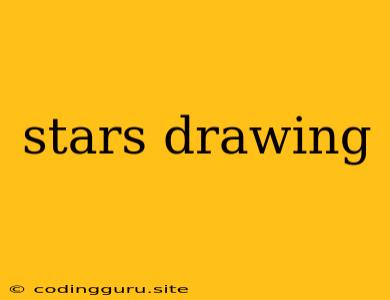Stars: A Guide to Drawing Celestial Beauty
Have you ever gazed up at the night sky and been mesmerized by the twinkling stars? Their brilliance and mystery have inspired artists and dreamers for centuries. But capturing the essence of a star on paper can be a challenge. Don't worry, though! This guide will equip you with the knowledge and techniques to draw stars that will shine on your page.
Getting Started: Materials & Inspiration
What do you need?
- Paper: Choose a smooth, white paper for optimal detail and shading. Drawing paper, Bristol board, or even watercolor paper work well.
- Pencils: A range of pencils, from a hard 2H to a soft 6B, will give you flexibility in creating different tones.
- Eraser: A good eraser is crucial for correcting mistakes and blending.
- Sharpener: Keep your pencils sharp for clean lines.
Where to find inspiration?
- Real Stars: Step outside on a clear night and observe the stars. Study their shapes, sizes, and how they appear in constellations.
- Images: Search online for images of stars, star clusters, and galaxies. Look at different artistic interpretations for inspiration.
- Reference Books: Astronomy books offer detailed diagrams and illustrations of stars.
Types of Stars: More Than Just Points of Light
Stars come in a variety of shapes, sizes, and brightness. Let's explore some of the most common types:
- Point Star: The classic, five-pointed star is a simple and elegant design. Use a ruler for precise angles or freehand it for a more whimsical look.
- Spiral Star: Create a sense of movement and energy with a spiral star. Start with a spiral shape and then add radiating lines.
- Starburst: A starburst features a central point and radiating lines that create a burst of light. This is effective for representing the brilliance of a star.
- Cluster: Draw multiple stars together to create a star cluster. Experiment with different sizes and positions to capture the beauty of a celestial grouping.
- Realistic Stars: For a more realistic approach, draw a round shape with a bright center and gradually fading edges. This technique creates a sense of depth and luminosity.
Drawing Techniques: Unlocking the Secrets of a Star
Basic Techniques:
- Point Star: Start with a center point and then draw five lines extending outwards. Adjust the angle of the lines to create different shapes and variations.
- Spiral Star: Begin with a small spiral shape and gradually increase the size as you draw the radiating lines.
- Starburst: Draw a central point and then use a ruler to create evenly spaced lines radiating outward.
- Cluster: Draw multiple stars using different techniques, sizes, and positions. Create a sense of depth and perspective.
- Realistic Stars: Use a light pencil to sketch a circle. Then, gradually add more shading around the center to create a bright core.
Adding Dimension & Texture:
- Shading: Use a soft pencil to add shading around the edges of the star. This creates a sense of depth and dimension.
- Blending: Use your finger or a blending tool to smooth out the shading for a seamless look.
- Texture: Add texture to the star with a textured brush or a soft eraser. This can create the effect of a glowing surface or a cosmic dust cloud.
Beyond the Basics: Expanding Your Artistic Vision
Adding Color:
- Color pencils: Use color pencils to add color to your stars. Experiment with different shades of yellow, white, and blue for a realistic effect.
- Watercolors: Watercolors are a beautiful medium for creating soft, luminous stars. Use washes of color to create a sense of depth and dimension.
- Acrylics: Acrylics are a versatile medium that can be used to create bold, vibrant stars. Experiment with different techniques and layers of color.
Creative Approaches:
- Constellations: Draw a constellation by connecting multiple stars with lines. Research different constellations and learn their stories.
- Galaxies: Create a galaxy by drawing a swirl of stars and nebulae. Use a range of colors and textures to capture the beauty of space.
- Abstract Stars: Experiment with abstract shapes and forms to represent the abstract nature of stars. Use colors, textures, and patterns to create a unique and expressive piece of art.
Conclusion:
Drawing stars is a journey of discovery and creativity. With practice and experimentation, you can learn to capture the beauty and wonder of these celestial objects on paper. Embrace your inner artist and let your imagination soar!
